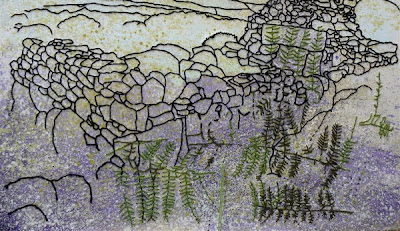
I would rather not go.....
In this work, ten years after which switching attention from Figurative Drawing, Pinhole Photography, printing techniques and installation I have combined painting, drawing and embroidery, based pretty much on drawing but all tangled up in the time honoured chaos of ritual - my ritual as well as those commonly considered to be public displays of amelioration.
This use of the stitched line extends the execution time considerably, the amount of work depends upon the degree of detail and the guage of the yarn. Using organically produced woolen yarns sourced within Cornwall creates an additional hurdle, not just the cost and the sourcing complications but actually crewelling the yarns through the panel, much easier with acrylic yarns or even the Oakum, jute like yarn for caulking wooden boats, I used Oakum for the Ripple Lugger, an image of the Cornish Lugger.
Tarred Marlin is purchasable from London firm;
flintsmarine.co.uk
The difference between this medium and painting is not that different except that the stitching seems to go on and on forever, the paint is acrylic gesso, like traditional gesso but with higher quality pigments and easier to use layering or lake effects - a technique I adapted from experience working with scenic artists. This extensive process is time sapping but it effectively allows far more of a "layering" effect, which is why I mention the use of Lake colours or transparent watercolour. Techniques with paint tend to over complicate the vital schism that combining quite polarized "crafts" create. Oil paint is often associated with high art whereas embroidery is a craft - low art , decoration. Oil painting never really imposed itself into many of the regional cultures of the United Kingdom, the English were not exactly regarded for their oil painting rather more was made of watercolour .
In this work, ten years after which switching attention from Figurative Drawing, Pinhole Photography, printing techniques and installation I have combined painting, drawing and embroidery, based pretty much on drawing but all tangled up in the time honoured chaos of ritual - my ritual as well as those commonly considered to be public displays of amelioration.
This use of the stitched line extends the execution time considerably, the amount of work depends upon the degree of detail and the guage of the yarn. Using organically produced woolen yarns sourced within Cornwall creates an additional hurdle, not just the cost and the sourcing complications but actually crewelling the yarns through the panel, much easier with acrylic yarns or even the Oakum, jute like yarn for caulking wooden boats, I used Oakum for the Ripple Lugger, an image of the Cornish Lugger.
Tarred Marlin is purchasable from London firm;
flintsmarine.co.uk
The difference between this medium and painting is not that different except that the stitching seems to go on and on forever, the paint is acrylic gesso, like traditional gesso but with higher quality pigments and easier to use layering or lake effects - a technique I adapted from experience working with scenic artists. This extensive process is time sapping but it effectively allows far more of a "layering" effect, which is why I mention the use of Lake colours or transparent watercolour. Techniques with paint tend to over complicate the vital schism that combining quite polarized "crafts" create. Oil paint is often associated with high art whereas embroidery is a craft - low art , decoration. Oil painting never really imposed itself into many of the regional cultures of the United Kingdom, the English were not exactly regarded for their oil painting rather more was made of watercolour .









